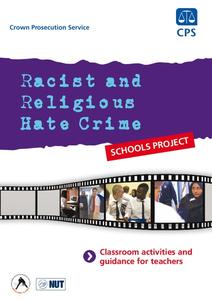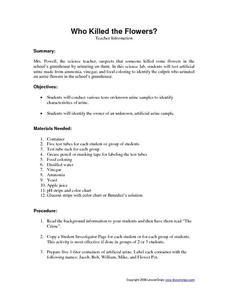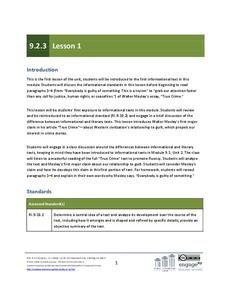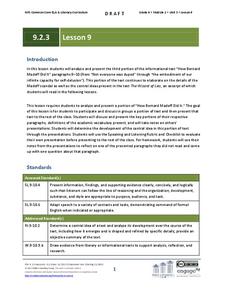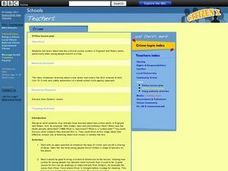Media Smarts
Perceptions of Youth and Crime
Explore the potential for bias in the news and in scholars' own attitudes and opinions. Begin with a quiz on youth crime to see how learners perceive crime among their peers. After looking at the correct answers, put individuals in...
Teaching Tolerance
Critiquing Hate Crimes Legislation
The high school instructional activity explores what hate crimes are and how the government has responded to those crimes. Academics read legislation, analyze political cartoons, and complete hands-on-activities to understand what...
Curated OER
Story Map for Crime and Punishment Part I, Chapters 1-5
While reading chapters one through five of Crime and Punishment, focus your readers with this guide. Eight questions are given here, encouraging the reader to study the protagonist and the struggles that ensue with the surrounding...
Planet e-Book
Crime and Punishment
Can an action be so bad that you are sickened with guilt? Rodion Romanovich Raskolnikov, the main character in Fyodor Dostoyevsky's Crime and Punishment, believes that committing a crime could be the answer to his troubles. However, the...
Crown Prosecution Service
Racist and Religious Hate Crime
Address the current political climate with a series of thought-provoking activities. A resource packet provides pupils with strategies for challenging racist behavior and religious prejudice, and moves them from being passive bystanders...
Curated OER
Crime and Punishment Essay Questions
In this literature learning exercise, students respond to 12 short answer and essay questions about Dostoevsky's Crime and Punishment. Students may also link to an online interactive quiz on the novel at the bottom of the page.
Curated OER
Committing Crime or Just Having Fun?
Students breakdown different types of youth crime/gangs. Students evaluate the power of peer pressure. Students identify and offer advice for dealing with peer pressure. Students encounter the theory of phenomena.
Curated OER
Juvenile Crime in America: What Do We Value
Young scholars investigate the statistical data provided in the Juvenile Offenders and Victims National Report. Students work in groups to create a story around a juvenile crime using the perspective of the juvenile offender, and...
Lesson Snips
Who Killed the Flowers?
This could be really good, or it could be really bad! The crime to be solved is, "Who went pee in the flowerpot?" Given four imitation urine samples, young chemists or crime scene investigators perform pH, glucose, and turbidity tests to...
EngageNY
Grade 9 ELA Module 2, Unit 3, Lesson 1
"True-crime stories, murder mysteries, up-to-the-minute online news reports, and (as always) rumor and innuendo grab our attention faster than any call for justice, human rights, or ceasefires." Or so says Walter Mosley in his Newsweek...
Curated OER
The News Behind the Story
What a fun way to analyze plot, setting, and character. Learners review story elements, read a short fictional story, then turn the events of that story into a headlining news paper article. Not only does this lesson engage critical...
EngageNY
Grade 9 ELA Module 2, Unit 3, Lesson 9
Are we interested in crime stories because we either identify with the victims or enjoy watching the rich suffer? Do we feel guilty and want someone to take our blame and let us feel innocent? Groups investigate how the author of "How...
BBC
Crime
Crime and punishment! Learners discuss the law, civics, and crime in the UK. They brainstorm lists of crimes and possible punishments, complete activities on a website, role-play a Juvenile Court scenario, and try to think of ways they...
BBC
Crime: Justice
Are the juvenile courts fair? Learners read a bit from the classic Oliver Twist to consider how young people are treated and represented when they've been accused of a crime. They read a case study from their books, discuss children's...
Curated OER
Adjectives in Stories
In this adjectives worksheet, students match adjectives with descriptions of different types of stories. Students then read a news report and fill in the spaces with adjectives that begin with the specified letters.
Curated OER
Crime and Young People
Young scholars read the story, "Police in Schools". They view a list of common offences committed by young people and identify the victims of these offences and consider how the offence would affect those people.
Curated OER
Planting Clues in Short Stories
Students examine short stories to determine how clues are planted in story stories of the mystery genre. They look at how Edgar Allan Poe planted clues in "The Purloined Letter." They write an original short story in which they plant...
EngageNY
Grade 9 ELA Module 2, Unit 3, Lesson 5
After rereading the full text of Walter Mosley's essay "True Crime," groups complete an evidence collection tool worksheet, and then class members independently draft a multi-paragraph, evidence-based response that identifies how Mosley...
Scouts
The Deadly Picnic: A Lab on Deductive Reasoning
Whodunnit? Find out who killed Mr. Brooks through a logical examination of evidence. Class members fill out a couple of data tables to help them pin down the suspect. After they've figured out just who the culprit is, pupils compose...
Curated OER
Hanging the Sheriff, The Story of Henry Plummer
Learners study who Henry Plummer was in relation to the history of Bannack, Montana. They examine his role as sheriff, what types of crime he dealt with and participate in a mock trial to determine if his hanging was justified.
Curated OER
Character's Motive: Sammy Keyes and the Hollywood Mummy
Sixth graders explore language arts by completing a reading comprehension worksheet. In this character study lesson, 6th graders read a crime story and investigate which character they belive committed the crime. Students complete a...
Curated OER
Detective Fiction: Focus On Critical Thinking
Turn your 6th graders into detectives while growing their love of reading. Using critical thinking skills, they will be able to describe the five basic elements of detective fiction, read detective novels, make predictions, use the...
EngageNY
Grade 9 ELA Module 2, Unit 3, Lesson 8
Class members continue reading "How Bernard Madoff Did It" and annotate how the author refines his idea that the Madoff scandal grabbed the attention of a public fascinated with crime stories.
K12 Reader
Tension in the Pit and the Pendulum
Readers will get a peculiar thrilling sensation from this reading comprehension exercise that asks them to identify how Poe uses repetition and sensory language to build tension in his short story, "The Pit and the Pendulum."






